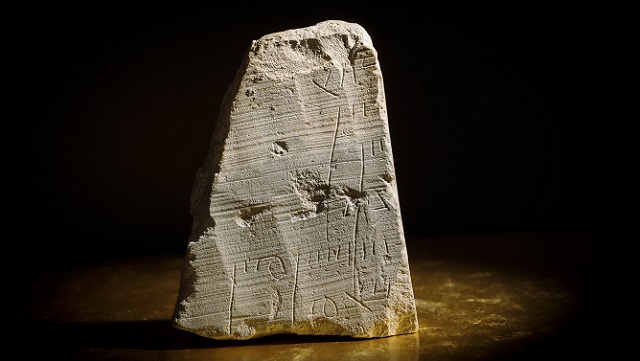They saved the receipt! Archeologists from the Israel Antiquities Authority (IAI) made a major discovery. A financial record from 2,000 years ago was uncovered on the Pilgrimage Road in Jerusalem’s City of David – the ancient city of Jerusalem located just south of the Old City Walls – in an area considered a bustling commercial area. The big question the archeologists are now asking is “who was Shimon.” Shimon is the name inscribed on the find, a small stone tablet fragment engraved with letters and numbers that is believed to have been a receipt.
We don’t know what the receipt was for – a cup of Starbucks coffee, or maybe a new TV – but it must have been something special.
IAI said that the tablet has seven partially preserved lines of an inscription including fragmentary Hebrew names with letters and numbers written beside them. For example, one line includes the end of the name “Shimon” followed by the Hebrew letter “mem,” and in the other lines are symbols representing numbers. Some of the numbers are preceded by their economic value, marked with the Hebrew letter mem, an abbreviation of ma’ot (Hebrew for ‘money’), or with the letter “resh, “an abbreviation of reva’im (Hebrew for ‘quarters’).
Will you offer us a hand? Every gift, regardless of size, fuels our future.
Your critical contribution enables us to maintain our independence from shareholders or wealthy owners, allowing us to keep up reporting without bias. It means we can continue to make Jewish Business News available to everyone.
You can support us for as little as $1 via PayPal at office@jewishbusinessnews.com.
Thank you.
Israel is certainly the place for great archeological discoveries. Just yesterday JBN reported on how an Israeli swimmer made an amazing historic find: a rare cargo of 1,800-year-old marble artifacts, borne in a merchant ship that was shipwrecked in a storm.
And already this year a 4,000-year-old ostrich egg was discovered in the Negev, elements of ancient Jerusalem’s fortifications and a mysterious hand imprint carved in a rock dating back to the tenth century were uncovered in another IAA project, a Byzantine-era church dating back to the 6th Century was uncovered in Jericho.
Also in the City of David, an Israeli teenager, a volunteer, uncovered a rare gold bead from the end of the Roman era while taking part in the sifting project at the Archaeological Experience at the Israel Antiquities Authority’s excavation of the Pilgrimage Road in the City of David in Jerusalem.
In a recent article published in the archaeological journal ‘Atiqot by Nahshon Szanton, Excavation Director on behalf of the Israel Antiquities Authority, with Epigraphist, Prof. Esther Eshel of Bar Ilan University, it is noted that four other similar Hebrew inscriptions have been documented so far in Jerusalem and Bet Shemesh, all marking names and numbers carved on similar stone slabs and dating to the Early Roman period. This, however, is the first inscription to be revealed to date within the boundaries of the city of Jerusalem at that time.
According to the researchers, the inscription was carved with a sharp tool onto a chalkstone (qirton) slab. Apparently, the stone slab was originally used as an ossuary (burial chest), commonly used in Jerusalem and Judea during the Early Roman period
(37 BCE to 70 CE). Ossuaries are generally found in graves outside the city, but their presence has also been documented inside the city, perhaps as a commodity sold in a local artisan’s workshop or store.
What archeologists are calling an intriguing find was discovered in the lower city square, located along the Pilgrimage Road. This Road, extending some 600 meters, connected the city gate and the area of the Siloam Pool in the south of the City of David to the gates of the Temple Mount and the Second Temple, and essentially served as the main thoroughfare of Jerusalem at the time. This unique discovery joins similar findings uncovered in the area, attesting to the commercial nature of the area.
The stone tablet, on which the inscription was engraved, was retrieved from a tunnel of a previous excavation at the site, dug at the end of the 19th century by British archaeologists, Bliss and Dickie, who excavated tunnels and pits along the Stepped Street. Although the inscription was found out of its original archaeological context, it was possible to date it to the Early Roman period, at the end of the Second Temple period, based on the type of script, the type of stone slab and its similarity to other contemporary inscriptions.
According to the researchers, “the everyday life of the inhabitants of Jerusalem who resided here 2,000 years ago is expressed in this simple object. At first glance, the list of names and numbers may not seem exciting, but to think that, just like today, receipts were also used in the past for commercial purposes, and that such a receipt has reached us, is a rare and gratifying find that allows a glimpse into everyday life in the holy city of Jerusalem”.




